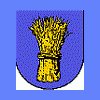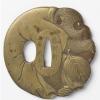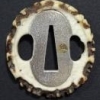
dir
Members-
Posts
31 -
Joined
-
Last visited
Profile Information
-
Gender
Male
-
Location:
The Netherlands
-
Interests
tsuba, kozuka, other sword fittings
Profile Fields
-
Name
David
Recent Profile Visitors
360 profile views
dir's Achievements
-
dir started following Edo? sanmai tsuba... and fittings , Seiin - unrecorded signature? , Sado Island School Tsuba and 5 others
-
Happy New Year to all! I'd appreciate any further information on the attached tsuba which I recently acquired please. I tried to read the signature and using Self and Hirose Japanese Art Signatures came up with sei, shi or kiyo (647) for the first character and possibly tane (823) for the second. However, there seems to be no such artists named Seitane or Shitane and the single Kiyotane given in Haynes (H 03356) has a different character. On the other hand, the third character looks remarkably like the bottom kao given in Haynes for Bairyuken Kiyonaga (H 03291)! I asked Robert Haynes for his opinion and he said the signature read Seiin and was unrecorded. He knew nothing further about him, but he thought it appears he might have been a student of the Goto Seijo School. (I have just found this School was discussed on here in January 2012!) If anyone can provide further light on the signature, that would be very helpful. Thanks and regards David
-
Sorry to be coming to this topic rather late, but the following comments may just be of interest. I have several tsuba with a rope mimi in my collection, but I have just acquired from Japan an unsigned tsuba (not fully sure what the design represents) with a looser rope that the other ones I have (see below). It is very similar to the two given at the start of this thread and thought perhaps to be Sado work. Looking further into Sado Island tsuba, I came across a couple of other threads on here relating to the Sado School. The very next tsuba I picked up to catalogue is the one below of three cranes (one with open beak) - also acquired from Japan. This double convex thin mimi tsuba is signed and amazingly and coincidentally the Province is Sashu (Sado). Although the artist's name is not so easy to discern, comparing to other signatures I am fairly confident that it reads Toshisada. Regards David
-
Could anyone help me please with the significance (if any) of this kozuka? It appears to be a tethered hawk on a perch atop a decorated stand above a recumbent ferocious-looking shishi. The lengthy tether has many loops and tassels at the end. I thought it was an eagle at first - but a little research revealed that hawking/falconry was popular with samurai in Japan and are often depicted on a perch with a tether in paintings and prints. The hawk was considered a symbol of endurance and status, while the shishi, of course, is a symbol of strength, courage and protection. I couldn't find anything relating to a shishi being depicted with a hawk and whether the end of the stand actually is thrust into the shishi is hard to decide. It may simply be two favourite symbols used together to signify that the kozuka belonged to a brave elite samurai! I think the metal is perhaps sentoku or shinchu and there are copper highlights on the hawk, shishi, decoration and cords. If anyone has any ideas I'd be pleased to hear them. Thanks and regards David
-
I google translated the entry and it does not add anything more than is in the Haynes Index entry, except it just says mid-Edo.
-
Thank you for looking that up, Steve! Much appreciaterd! Interesting to see the page - I didn't know the book contained no images. Regards, David
-
I recently acquired a tsuba from a friend returning from Kamakura (attached) and had trouble finding the artist - though I could see he was living in Choshu. I had checked all the kundoku character variations with no luck, but neglected to check the single onduko combination since most of my signed tsuba are kun. Bob Haynes and Elliott Long gave me the correct reading - Yuji (Haynes H 12358). I haven't come across this name before in any of my signature books and there seems to be just a single source given for him In the Haynes Index. The source notes the signature is from a tsuba with grass and flowers design with a date of around 1800. My tsuba looks like ginko leaves and must surely be by the same chap. As I don't have Toso Kinko Jiten in my library (yet!) I wonder whether someone who does would be kind enough to look up the source and post a picture of the tsuba if possible please. The source is W–591–U-3. W signifies Wakayama, followed by the page number (591), the U (meaning Upper section of that page, and the name entry (3) found by counting all names on that page starting from the right and counting left (instructions from the Haynes Index). Thank you very much! Regards, David
-
Wow! What a find. Thanks so much for this info! Do you have any thoughts about the thicker rim at the top? Regards David
-
Thanks everyone for the comments and detective work! Amazing coincidence to have found a similar one - the auction one has gold leaves and looks a little bit finer than mine. And mine is not signed as the auction one is said to be (Mumei). The description is rather simple and says nothing about the "half-circle" lines? I did think at first the leaves might have been bamboo, but then thought that they were not quite right, as Richard noted. But then it begs the question - mine was actually bought in Japan just recently - so is it a copy or is it an unsigned version from the same chap or,...?! Regards David
-
Having read the posts on tachi tsuba and Bob Hayne's interpretation in his Study book, I wonder about this one I recently acquired. Many tsuba in my collection have the main motif at the bottom or lower sides rather than at the top. (There may be a piece of inlay missing at bottom right). And since I haven't yet identified the plants I don't know whether they are leaves or flowers and whether they are upside down! At the top the rim is a bit thicker than at the other three lobes - so the plants might be growing out of the earth? At either side are two semi-circular grooves which appear to have been silver lined and which meet up with the rim. On the reverse there is only one on the left for some reason. An initial thought was that the tsuba lobes had been broken and rejoined, but this does not seem to be the case. So, I was wondering whether this tsuba may have started life for a tachi and then was repurposed for a katana with the hitsu added later? Size is H 8.4 cm, W 8 cm, T 4.1mm, weight 139gr. Any thoughts (and views on the plants/flowers) would be gratefully received. Thanks and regards David
-
Thanks for all your comments and ideas. I agree it is not a very fine specimen and does look a but rustic - that might fit in with my initial lightning interpretation! It is also fairly light (41gr) - the dimensions are 5.9x5.9 cm, and 3.4mm at rim. I will plough through some of my books and let you know if I come across anything resembling it! Regards David
-
Very interesting! Thank you, Mauro. I know Elliott and often look at the site, but had missed this one! Regards David
-
I have a second tsuba which I am unsure about. At top, bottom and one side are what is perhaps stylized lightning (sort of spiral square - raimon). At right is another symbol - which might be a stylized vajra? Around the rim on each plate side I.e. not the outside of the rim itself) and wavy lines or scrolls - which I thought might be clouds - in keeping with the lightning (bolts)? If anyone could shed any light on it then I'd be grateful. Thanks and regards David







